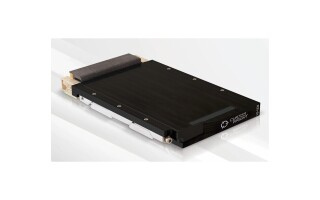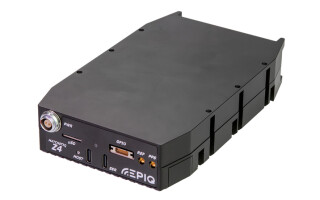MC4 telemedicine brings e-Health to the battlefield:Interview with Army Lieutenant Colonel William Geesey, product manager, MC4
StoryApril 11, 2011
Editor's Note: Battlefield medicine has come a long, long way since the Civil War, and advanced many clicks beyond what was commonplace only 10 years ago in OIF. The U.S. Army's Medical Communications for Combat Casualty Care is integrating and deploying the best COTS technology available to further soldiers. I spoke with Lieutenant Colonel William Geesey, product manager and visionary?for MC4. Edited excerpts follow.?
Editor's Note: Battlefield medicine has come a long, long way since the Civil War, and advanced many clicks beyond what was commonplace only 10 years ago in OIF. The U.S. Army's Medical Communications for Combat Casualty Care (MC4) is integrating and deploying the best COTS technology available to further soldiers.: golden hour, aid in mental health, and even facilitate remote surgeries directed by off-site surgeons. I spoke with Lieutenant Colonel William Geesey, product manager and chief visionary for MC4. Edited excerpts follow.
MIL EMBEDDED: Let’s take it from the top: Where are you based, and what is MC4?
GEESEY: I’m based in Fort Detrick, Maryland, and MC4’s higher headquarters is the Program Executive Office Enterprise Information Systems (PEO EIS). MC4 fields, trains, and sustains a comprehensive medical IM/IT [Information Management/Information Technology] system that has three primary capabilities: 1) an electronic medical record capability; 2) a medical logistics suite of applications; and 3) medical surveillance and command and control. Additionally, there’s a suite of joint software applications developed by the military health system and employed by all of the services. We also have several other innovations in the works.
MIL EMBEDDED: Let’s dig a bit deeper. First, what does MC4 do, more specifically?
GEESEY: In addition to what I’ve mentioned, we also have a responsibility to implement Army-unique requirements. One of those is the Joint Theater Trauma Registry [JTTR], a software application in which medics in-theater can capture all data available from point of injury through the evacuation chain to facilitate research on better ways to create material solutions for saving soldiers’ lives.
Another thing specifically mentioned in our ORD [Operational Requirements Document] is telemedicine/telehealth. In the past 18 months, we had a successful demonstration of telesurgery capability in Iraq in which a general surgeon performed a very difficult, complicated surgical procedure and saved a patient’s life (Figure 1). This particular surgical procedure was not one the surgeon was familiar with, but was able to perform via telemedicine consultation with a CONUS [Continental United States] expert. We’ve also done some experimenting with TeleBurn, where a burn surgeon in Iraq wanted to provide consultation to other physicians with burn patients.
Figure 1: Lt. Col. T. Sloane Guy IV received real-time consultation from providers at Brooke Army Medical Center (BAMC) in Fort Sam Houston, Texas, during a complex and rare surgical procedure while deployed with the 47th Combat Support Hospital in Mosul, Iraq. Photo courtesy of U.S. Army/MC4
(Click graphic to zoom by 1.9x)
MIL EMBEDDED: You’ve described Army-unique requirements like the Joint Theater Trauma Registry, and also telemedicine – anything else for MC4?
GEESEY: Yes, we have something that’s really current: a pilot telebehavioral health project in Afghanistan and Iraq. MC4, PM Army Knowledge Online, the Office of the Surgeon General for the Army, and TATRC (the Telemedicine Advanced Technology Research Center) have collaborated on this project. The purpose is to develop new capabilities to improve the delivery of behavioral health services to deployed forces in Operation Enduring Freedom and Operation New Dawn.
There might be a situation, for example, in Afghanistan where soldiers are spread throughout many different bases. A divisional unit in Afghanistan might have one psychiatrist assigned, who would review the types of medications soldiers might take for depression or related issues. We’ve been able to set up a teleconsultive environment where a soldier goes into a clinic at one site with a non-mental-health-care provider, say a family practice physician, and engages in a teleconsultation with a psychiatrist located elsewhere. Of course, that allows the psychiatrist to perform a greater number of consults because they don’t have to travel everywhere.
MIL EMBEDDED: What’s involved in these teleconsultations, technically?
GEESEY: In Iraq, they’re doing physician consults using the TANBERG system, which provides a VTC
capability using a camera and a computer. There are a lot of bandwidth restrictions and challenges in-theater, and this particular solution can regulate the flow of voice and video based on available bandwidth.
MIL EMBEDDED: Does the computer use a satellite uplink/downlink, or is it just plugged onto SIPR/NIPR?
GEESEY: It can do both SIPR and NIPR in Iraq, and they’re currently operating it on the NIPR. In Afghanistan, we’re currently operating it on the SIPR because there’s greater SIPR connectivity than NIPR connectivity there. So right now, they’re using the TANBERG in Iraq, but in Afghanistan they’re using MC4-supplied hardware, software, webcams, and headsets for provider-to-provider video teleconferencing.
MIL EMBEDDED: What’s the next step for MC4 technology?
GEESEY: The next step is to adapt a text-based secure chat capability using Army Knowledge Online [AKO]. A solider would be able to log in using their common access card that identifies who the individual is. And then there would be a link on the AKO website that says there’s a mental health provider available; then if soldier wants to chat with someone, they could go ahead and click on that. This would be very useful in the field, as soldiers might receive the Dear Jane letter from home or something like that, or be bothered by a death of a family member or some other stressful event, combat event, or whatever. The part we’re working on now is what we call a chat queuing feature. So if today I go in and speak with Dr. Smith, and the next day I want to follow up with Dr. Smith, I’m able to choose Dr. Smith versus just the next available person. And with the right security features, the soldier could sit in the privacy of their own room and talk to a mental health provider without anybody knowing.
MIL EMBEDDED: Makes sense. You talked about telemedicine, remote surgery teleconsultations, and mental health professional conferencing and secure chats. Are these all to be implemented by DoD personnel?
GEESEY: Currently, all of the MC4 telemedicine activities are with either military providers or DoD-employed civilians. For CONUS, though, there’s a network and there are consultations provided through the contracted support, contractor network, and Tri-Care support network. But right now in-theater, it’s just military-to-military providers.
MIL EMBEDDED: Are there active plans within MC4 to describe to the civilian population the things implemented in MC4?
GEESEY: There are several media outlet methods for that. As far as peer-reviewed journals, there has been some documentation and there’s actually an article that I’m collaborating on that we’re looking to get into a peer-reviewed journal at some point, talking about some of these telemedicine accomplishments and uses in the combat zone.
MIL EMBEDDED: Going back to the technology … what about other future technologies for MC4 – anything else in the works?
GEESEY: Yes, one thing is hands-free electronic medical records. The point of injury where a medic or a buddy is rendering aid is called care under fire, which is very difficult to document. A number of different handheld devices require a stylus, but it’s hard for anyone to document care at the same time they’re applying a tourniquet. And, of course, that handheld doesn’t necessarily have connectivity because the envisioned network doesn’t really exist yet to allow data to flow ahead of the patient.
So what we envision in the future is PEO Soldier putting radios on every deployed soldier. So we’re working with DARPA, TATRC, and a couple other organizations on a digital voice recorder that can suppress the background noise of helicopters, gunfire, and those sorts of things. And then we’re also working on automatic speech recognition. To process spoken words, technology such as Dragon NaturallySpeaking version 10 is actually on our hardware configurations, available for providers to use in-theater. So the medic at the point of injury would speak into that microphone, which would create a .wav file that would then be transferred back to the combat support hospital. That spoken text would then be processed into recognizable text and inserted into the medical record.
MIL EMBEDDED: Any plans for smart devices?
GEESEY: We’ve been experimenting with putting our applications on the iPad, iPhone, and other Droid-type devices, and we’ve been able to get our applications to work on those devices. The Army also has the Army Training Network to Go in which a soldier can download manuals onto their iPad or iPhone. MC4 training products are being piloted on the next version of ATN2GO. As far as training, we’re leveraging Defense Connect Online to make our applications and systems training materials more readily available to soldiers using a ‘Go mobile device.
MIL EMBEDDED: Wow, you folks really have a lot going on. But if you wanted to close with a mission statement for MC4, what would it be?
GEESEY: We are working to improve the availability of medical information – whether it’s patient health records, medical supply information, or situational awareness in command and control. Our goal is to seamlessly make that data available throughout the chain of care from the far-forward point of injury all the way back to our CONUS-based hospitals like Walter Reed Army Medical Center. By having lifelong electronic medical records available to all providers along that route, the results include better patient outcomes and availability of information to facilitate medical R&D. Also, once the soldier transitions, we want to make those records available to the Veterans’ Administration so those soldiers receive the benefits to which they’re entitled.
Lieutenant Colonel William E. Geesey is the product manager for the Medical Communications for Combat Casualty Care (MC4) Product Management Office. With more than 26 years of active, reserve, and National Guard service, he has held a variety of management positions in medical logistics and healthcare administration.






